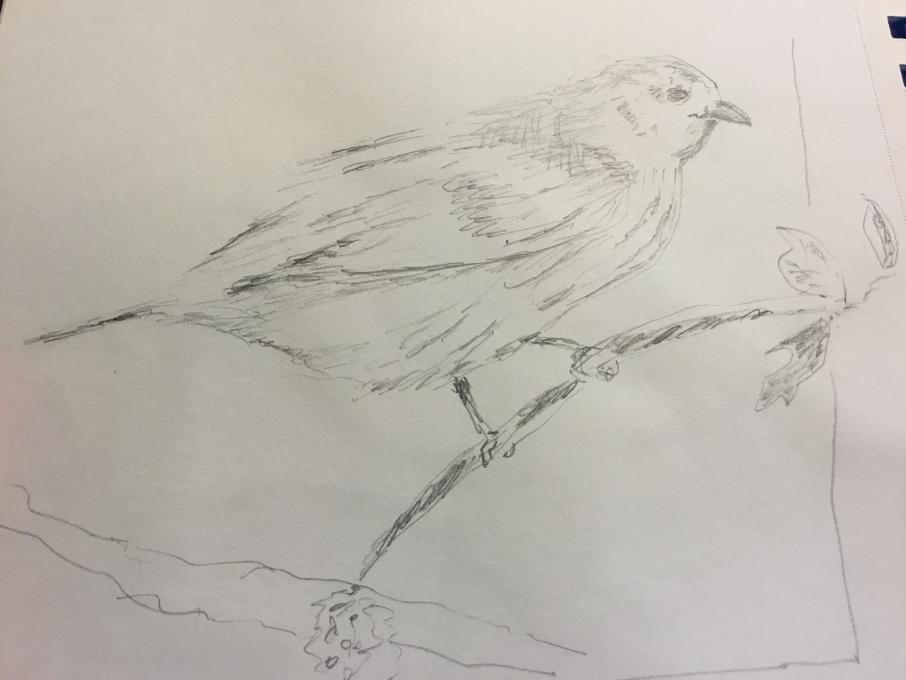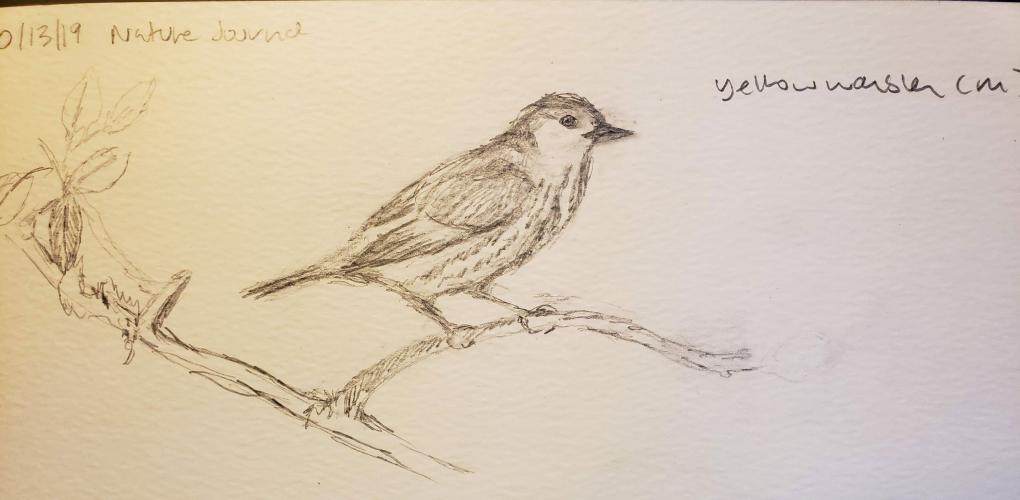The Cornell Lab Bird Academy › Discussion Groups › Nature Journaling and Field Sketching › Jump Right in!
-
1. Drawing from a photo gives you the time, and zoom feature, to capture details. It also gives you the time to practice being able to have your hand do what your eye sees - not an easy feat. Just drawing what I see is challenging. 2. The details of the shape are much more apparent when you are trying to recreate it. Differences in markings are more striking, such as the red lines which are more loose, random and wider as opposed to the black lines created by the folded wings which are much more defined and straighter.

-
 I have drawn from photos before and though I know it is not ideal, it does help thatthe subject is not moving. I am hoping for tips on sketching a mobile subject. The same day I sketched this I tried to sketch a kingfisher that flew away and tried to fill in the gaps from memory. That was difficult for me. My husband photographed the bird, I may go back and try again. I have tsken a Natural History and Illustration course previously and getting proportions right is still a challenge for me. My goal is to keep a nature journal using watercolors. I am new at watercolors and hope to improve.
If I were not asked to draw this bird, I wouldn't have noticed its peculiar slope on the top of its head or position of its claws. This makes a difference when nature journaling because you are studying the subject and learning about its body shape and positoning.
I have drawn from photos before and though I know it is not ideal, it does help thatthe subject is not moving. I am hoping for tips on sketching a mobile subject. The same day I sketched this I tried to sketch a kingfisher that flew away and tried to fill in the gaps from memory. That was difficult for me. My husband photographed the bird, I may go back and try again. I have tsken a Natural History and Illustration course previously and getting proportions right is still a challenge for me. My goal is to keep a nature journal using watercolors. I am new at watercolors and hope to improve.
If I were not asked to draw this bird, I wouldn't have noticed its peculiar slope on the top of its head or position of its claws. This makes a difference when nature journaling because you are studying the subject and learning about its body shape and positoning. -

-
1. On the plus side, drawing from the photo gave plenty of time to go back and correct mistakes or add things that I missed on first looking at the photo. The challenge was that the photo was always there reminding me of where lines were not quite right. 2. I don't think I would have noticed the two layers of feathers on the wing and that the black bars were more pronounced on the lower layer of feathers if I hadn't taken the time to draw it.
-

 My mom and I are taking this class together. Here are our warbler pictures. We are looking forward to learning more.
My mom and I are taking this class together. Here are our warbler pictures. We are looking forward to learning more. -
This was the first time in a long time that I have tried drawing and I found it very difficult to capture the essence of the warbler, it’s shape and in its environment. I liked experimenting with the watercolors which I have not used before and found that the colors were bleeding and distorted the image so I need to learn how to control that. I did notice more detail as I studied the photo and may try drawing a little more the next time to capture more detail.

-
 1) I really enjoyed drawing from the photo, but I felt nervous about sharing it. As with others in the class, I am a bit of a perfectionist and drawing has never been my strength. As a child I decided I wasn't very good at it and gave up on it by the time I was in middle school. I still enjoyed it, but I thought I would never get any better. I never took art classes and never gave it much thought. Now I am a homeschooling mom and I would like for my children to learn to draw and to nature journal. I have started attempting to teach myself to paint and draw better, but I still have to make sure I am not hyper-critical of my work. So the hardest part is not judging myself.
2) I feel that there is so much I miss when I take a photo over painting. I don't think I would have noticed how far the wing goes back, the transition of coloring from the shoulder to the wing tip, etc if I had taken a picture and moved on. I have also found that drawing and painting cause me to pay more attention to body shape, which is also helpful for identifying birds. For me the ultimate difference is that painting makes me slow down and take in the moment more. I find keeping a nature journal both helps me to remember where I have been and helps make the memory more vibrant in the first place.
1) I really enjoyed drawing from the photo, but I felt nervous about sharing it. As with others in the class, I am a bit of a perfectionist and drawing has never been my strength. As a child I decided I wasn't very good at it and gave up on it by the time I was in middle school. I still enjoyed it, but I thought I would never get any better. I never took art classes and never gave it much thought. Now I am a homeschooling mom and I would like for my children to learn to draw and to nature journal. I have started attempting to teach myself to paint and draw better, but I still have to make sure I am not hyper-critical of my work. So the hardest part is not judging myself.
2) I feel that there is so much I miss when I take a photo over painting. I don't think I would have noticed how far the wing goes back, the transition of coloring from the shoulder to the wing tip, etc if I had taken a picture and moved on. I have also found that drawing and painting cause me to pay more attention to body shape, which is also helpful for identifying birds. For me the ultimate difference is that painting makes me slow down and take in the moment more. I find keeping a nature journal both helps me to remember where I have been and helps make the memory more vibrant in the first place. -
1. I think I paid too much attention to detail which my drawing look kinda choppy and sloppy. It was definitely was a challenge for me. 2. I would probably missed the details of the feathers of the bird. I never realized there was so many layers. I think it would make a difference because a bird in nature is hard to get an up-close look at and they are likely to move around.
-
 I'm feeling so proud of this first drawing. Although I know a real bird will never hold this still it was awesome to get lost in the details. Bravo to those of you who went for it with the color and watercolors!
I'm feeling so proud of this first drawing. Although I know a real bird will never hold this still it was awesome to get lost in the details. Bravo to those of you who went for it with the color and watercolors! -

-
2. I know for me, when I have seen this bird "it's all yellow". Doing the sketch it allowed me to really look for details. Seeing the browns and black in the feathers, noting the truly black eye, and observing the shape, size and color of the bill are all details that, for me, may have gone unnoticed even if I had taken a photo but not completed a sketch! A great aid to honing observational skills.
-

-
 1. From my previous drawing experience, I was aware of and looking for the dark and light areas of the bird. What was more difficult was trying to get the proportions correct — the head is too big, the legs too short, and I did not leave enough room for the tail. I tend to draw large.
2. Drawing from the picture helped me see the different kinds of feathers on the warbler, e.g, long, distinct feathers on the wings and tail and shorter fluffier, feathers on the bird’s neck and belly, though I didn’t draw them as well as I wanted. If nature journaling, it would probably be harder to see th see details on a moving bird at a distance.
1. From my previous drawing experience, I was aware of and looking for the dark and light areas of the bird. What was more difficult was trying to get the proportions correct — the head is too big, the legs too short, and I did not leave enough room for the tail. I tend to draw large.
2. Drawing from the picture helped me see the different kinds of feathers on the warbler, e.g, long, distinct feathers on the wings and tail and shorter fluffier, feathers on the bird’s neck and belly, though I didn’t draw them as well as I wanted. If nature journaling, it would probably be harder to see th see details on a moving bird at a distance. -
This photo made me think of the bird topography drawings in field guides, there they are, the different coverts and feathers, the scapulars and alula and all that bird landscape. It is a treat to draw from such a clear photo as in life these little guys will never sit still long enough for you to count the visible primaries. It is challenging to try to record so much detail - in life it will be much more of an impression of a bright yellow flit among the leaves and maybe the male on territory singing. It is great though to see the feather tracts so clearly and this would be a good reference for bird topography. And the little feet with their long claws gripping the branch are neat to see.
 TT
TT -
 1. From Betsy: While drawing from the photo, I liked first setting the boundary/border for the drawing & then studying the relationships between the bird, the twigs, leaves, etc. I loved how the bird's legs formed an unexpected angle & how the eye looked so bright, with that one little sparkle. It felt really great again to put a plain #2 Ticonderoga in my hand & sketch away. Just getting started came really easily, as did the desire to sketch quickly. What was difficult was realizing that I'm a lot like this bird, always on the move, always looking for the next thing...not for survival's sake, like the warbler, but as my pattern of thinking & responding, my impatience. It was good to focus on the graceful bird, somewhat at rest, but...always on the move, always looking out, and always beautiful. Thank you! Because I can feel my brain operating differently when I draw, and that is so nice to notice, I was able to figure out how to "insert the image" into this e-mail & then to respond in this way. This is no small feat for me, so thank you for your deference, as I am sure this technology is easy stuff for many of you. It's not for me! I would imagine for many of us, though of course I don't really know, maybe especially for the artist who enrolled in this course as a birthday present, we have a chance to think about how we "see;" we have a chance to focus on ourselves as we focus on what we have always loved to do -- to draw. Ah, self-knowledge. Thank you!
2. I really noticed the shading & "implied" feathering & how the beak "sat." The veining on the leaves & the twists & textures in the twigs added to the action. The warbler's perch, his strong sure grip, though it lasts mere split seconds, ensures the bird's survival, as does, conversely, the letting go of the grip. This bird has a rounder head than I would have imagined. And what a sunny color. Look at how streamlined & aerodynamic he is. Like a sunbolt. Amazing!
1. From Betsy: While drawing from the photo, I liked first setting the boundary/border for the drawing & then studying the relationships between the bird, the twigs, leaves, etc. I loved how the bird's legs formed an unexpected angle & how the eye looked so bright, with that one little sparkle. It felt really great again to put a plain #2 Ticonderoga in my hand & sketch away. Just getting started came really easily, as did the desire to sketch quickly. What was difficult was realizing that I'm a lot like this bird, always on the move, always looking for the next thing...not for survival's sake, like the warbler, but as my pattern of thinking & responding, my impatience. It was good to focus on the graceful bird, somewhat at rest, but...always on the move, always looking out, and always beautiful. Thank you! Because I can feel my brain operating differently when I draw, and that is so nice to notice, I was able to figure out how to "insert the image" into this e-mail & then to respond in this way. This is no small feat for me, so thank you for your deference, as I am sure this technology is easy stuff for many of you. It's not for me! I would imagine for many of us, though of course I don't really know, maybe especially for the artist who enrolled in this course as a birthday present, we have a chance to think about how we "see;" we have a chance to focus on ourselves as we focus on what we have always loved to do -- to draw. Ah, self-knowledge. Thank you!
2. I really noticed the shading & "implied" feathering & how the beak "sat." The veining on the leaves & the twists & textures in the twigs added to the action. The warbler's perch, his strong sure grip, though it lasts mere split seconds, ensures the bird's survival, as does, conversely, the letting go of the grip. This bird has a rounder head than I would have imagined. And what a sunny color. Look at how streamlined & aerodynamic he is. Like a sunbolt. Amazing! -
 1. I felt that it was tricky getting the birds slight twist of the head okay. I am not a watercolorist, so I used marker to give an impression of the feathers and markings. It is a start.
2. I think you definitely notice more of the subtleties in the birds positioning and markings when you are trying to draw it. When I am out in the field photographing I try to get a clear, interesting shot within the birds environment at the moment. It might take a few photos to get enough data to make a good ID. I guess in nature journaling you have to decide if you want to make an impression and collect some data of your time in nature or if you are interesting in being more realistic.
1. I felt that it was tricky getting the birds slight twist of the head okay. I am not a watercolorist, so I used marker to give an impression of the feathers and markings. It is a start.
2. I think you definitely notice more of the subtleties in the birds positioning and markings when you are trying to draw it. When I am out in the field photographing I try to get a clear, interesting shot within the birds environment at the moment. It might take a few photos to get enough data to make a good ID. I guess in nature journaling you have to decide if you want to make an impression and collect some data of your time in nature or if you are interesting in being more realistic. -
1. How did you feel about drawing from the photo? What came easily and what was challenging? I think I was able to key in on some of the major shapes present in the bird's form, like the perfect arc from tail to leg, and the arch of the head and forehead. Letting the wing feathers define the side and rump was challenging because there's an outline, but then internal details and lines that define that outline. Which should I do first? Not sure why I compressed everything vertically. 2. Was there anything in the photo that you might not have noticed if you weren’t asked to draw it? Would this make a difference when nature journaling? Definitely how the wing feathers are laying along the flank and make fine little ledges on the rump and back. Also you can really see how the flattened bill wraps around the side of the head and points to the eye. The details of the toes wrapping around the branch also stood out to me.

-
 I agree with Barbara, it took me a while to take pencil in hand but I found the entire exercise rewarding. The more I looked and drew, the more I saw. Interesting!
I agree with Barbara, it took me a while to take pencil in hand but I found the entire exercise rewarding. The more I looked and drew, the more I saw. Interesting! -
Okay, I want to learn to draw. I purchased all the supplies listed for the course. I decided to do the first lesson of the course because I did not want to vacuum and iron today. Got to this point and balked. I did the vacuuming and the ironing while thinking about the task ask of me: draw this bird. So, I put on my big girl pants and ended up drawing the bird. I sure hope that we learn a few tricks about drawing here, I need them.
-
I'm grateful for a bird that is sitting still. My lived experience with warblers is that they don't do that anywhere near long enough for me to sketch! I never noticed how many toes they have. I'm happy with my sketch (though it took me some time to muster the courage to try it).

-
1. Drawing from a photo is both easier as the bird is still, but was more restricted as it doesn't always give the details I was looking for. 2. How the feet were wrapped around the twig was of interest to me. The photo allow me to pause and look more closely. Yes, I believe the detail makes a difference when nature journaling.
-
Drawing from a photo is a confidence builder, it allows me time to observe and note the details of what I am seeing. What I noticed in the act of drawing is being aware of proportions and that is a discipline I tend to ignore...

-
1. A photo is easier than trying to draw a warbler from life but it was still quite challenging. I struggled with the wings and head. 2. The greyish yellow nape of neck. When I see in the wild all I notice is yellow, the big dark eyes and chestnut streaked chest.
-

-
I don't mind working from a photo. Spotting warblers is bad enough, asking them to sit and pose is funny. I know there are things that you can miss from working from a photo, however, so some of the things I would be interested in from the perspective of looking at a bird are lost when working with a photo. The way the feather collect on the back for example can be represented with light/dark but I'd like to understand how they actually work mechanically- you can't observe that with a snapshot. I notice the drip the bird has on the branch and would like to understand that a little better- again it's not really observable from the photo.

Read More:
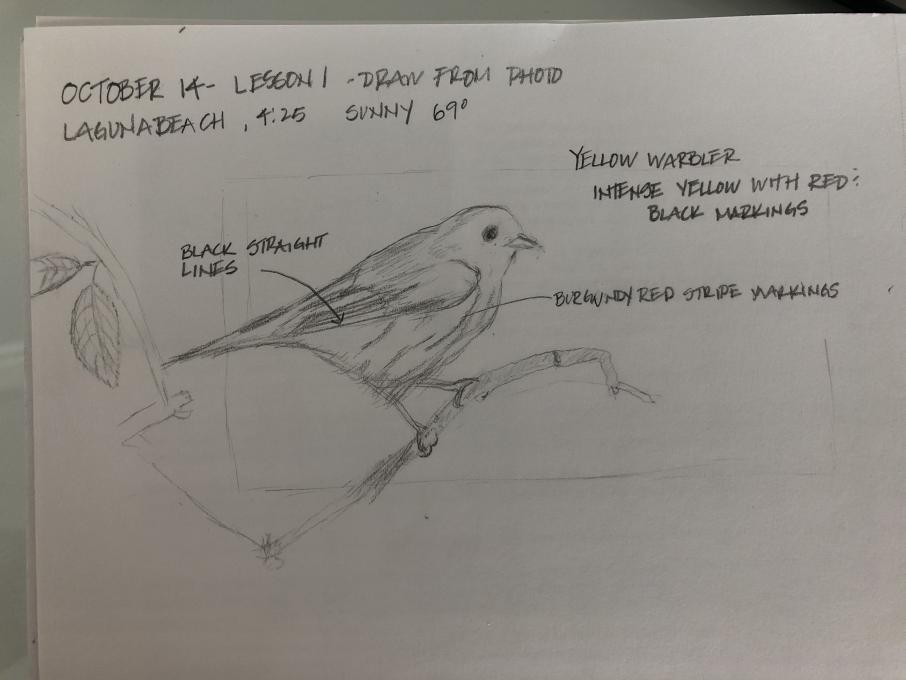
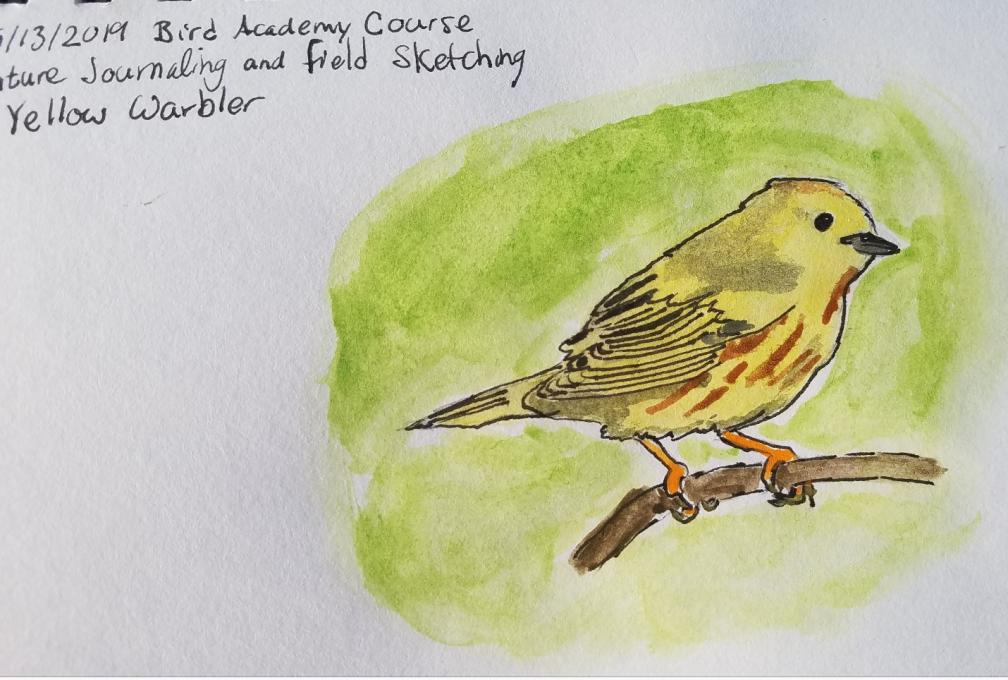 I have drawn from photos before and though I know it is not ideal, it does help thatthe subject is not moving. I am hoping for tips on sketching a mobile subject. The same day I sketched this I tried to sketch a kingfisher that flew away and tried to fill in the gaps from memory. That was difficult for me. My husband photographed the bird, I may go back and try again. I have tsken a Natural History and Illustration course previously and getting proportions right is still a challenge for me. My goal is to keep a nature journal using watercolors. I am new at watercolors and hope to improve.
If I were not asked to draw this bird, I wouldn't have noticed its peculiar slope on the top of its head or position of its claws. This makes a difference when nature journaling because you are studying the subject and learning about its body shape and positoning.
I have drawn from photos before and though I know it is not ideal, it does help thatthe subject is not moving. I am hoping for tips on sketching a mobile subject. The same day I sketched this I tried to sketch a kingfisher that flew away and tried to fill in the gaps from memory. That was difficult for me. My husband photographed the bird, I may go back and try again. I have tsken a Natural History and Illustration course previously and getting proportions right is still a challenge for me. My goal is to keep a nature journal using watercolors. I am new at watercolors and hope to improve.
If I were not asked to draw this bird, I wouldn't have noticed its peculiar slope on the top of its head or position of its claws. This makes a difference when nature journaling because you are studying the subject and learning about its body shape and positoning. 
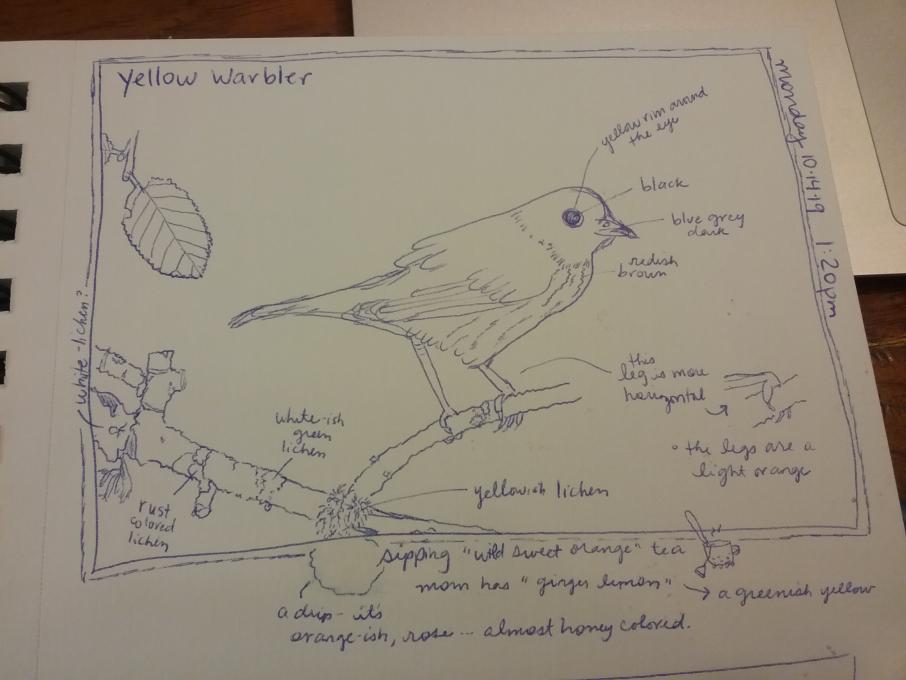
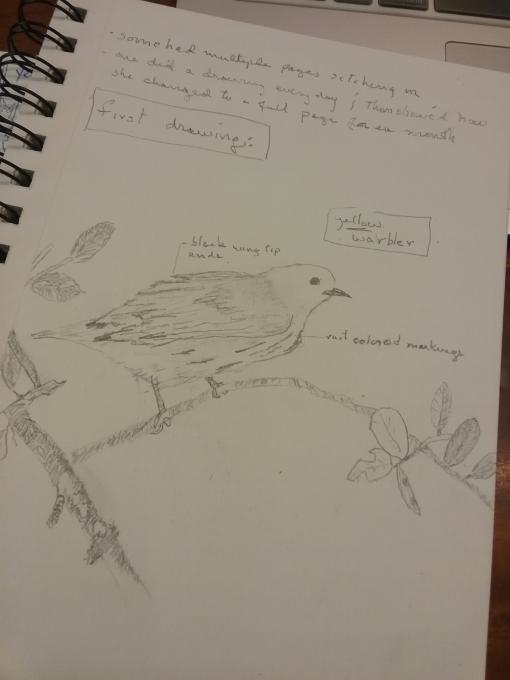 My mom and I are taking this class together. Here are our warbler pictures. We are looking forward to learning more.
My mom and I are taking this class together. Here are our warbler pictures. We are looking forward to learning more. 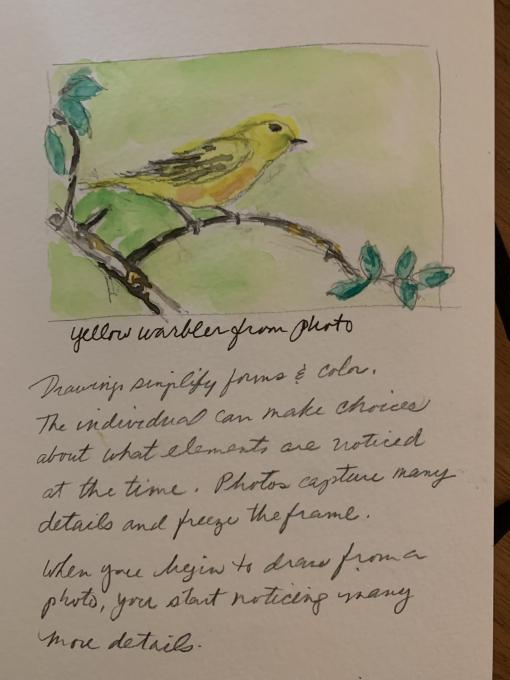
 1) I really enjoyed drawing from the photo, but I felt nervous about sharing it. As with others in the class, I am a bit of a perfectionist and drawing has never been my strength. As a child I decided I wasn't very good at it and gave up on it by the time I was in middle school. I still enjoyed it, but I thought I would never get any better. I never took art classes and never gave it much thought. Now I am a homeschooling mom and I would like for my children to learn to draw and to nature journal. I have started attempting to teach myself to paint and draw better, but I still have to make sure I am not hyper-critical of my work. So the hardest part is not judging myself.
2) I feel that there is so much I miss when I take a photo over painting. I don't think I would have noticed how far the wing goes back, the transition of coloring from the shoulder to the wing tip, etc if I had taken a picture and moved on. I have also found that drawing and painting cause me to pay more attention to body shape, which is also helpful for identifying birds. For me the ultimate difference is that painting makes me slow down and take in the moment more. I find keeping a nature journal both helps me to remember where I have been and helps make the memory more vibrant in the first place.
1) I really enjoyed drawing from the photo, but I felt nervous about sharing it. As with others in the class, I am a bit of a perfectionist and drawing has never been my strength. As a child I decided I wasn't very good at it and gave up on it by the time I was in middle school. I still enjoyed it, but I thought I would never get any better. I never took art classes and never gave it much thought. Now I am a homeschooling mom and I would like for my children to learn to draw and to nature journal. I have started attempting to teach myself to paint and draw better, but I still have to make sure I am not hyper-critical of my work. So the hardest part is not judging myself.
2) I feel that there is so much I miss when I take a photo over painting. I don't think I would have noticed how far the wing goes back, the transition of coloring from the shoulder to the wing tip, etc if I had taken a picture and moved on. I have also found that drawing and painting cause me to pay more attention to body shape, which is also helpful for identifying birds. For me the ultimate difference is that painting makes me slow down and take in the moment more. I find keeping a nature journal both helps me to remember where I have been and helps make the memory more vibrant in the first place. 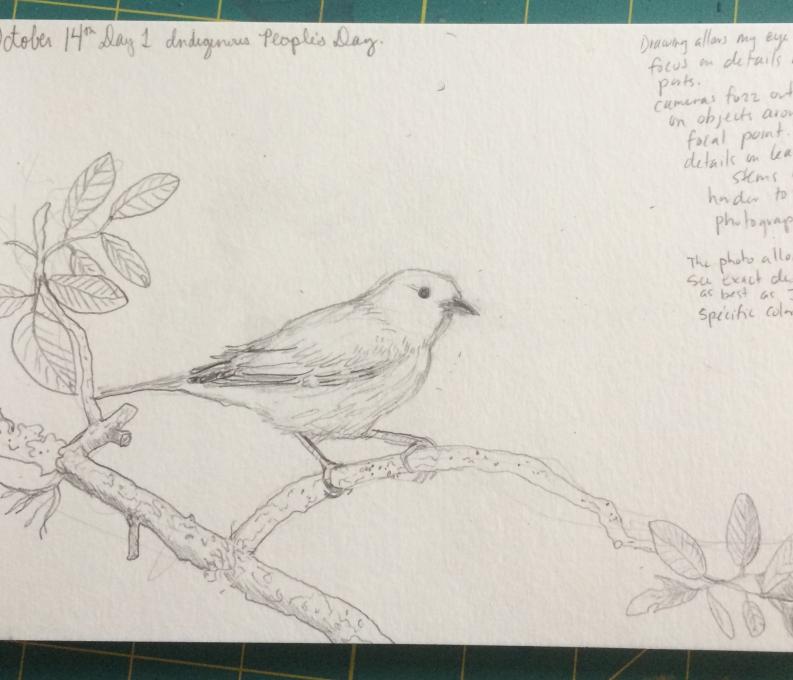 I'm feeling so proud of this first drawing. Although I know a real bird will never hold this still it was awesome to get lost in the details. Bravo to those of you who went for it with the color and watercolors!
I'm feeling so proud of this first drawing. Although I know a real bird will never hold this still it was awesome to get lost in the details. Bravo to those of you who went for it with the color and watercolors! 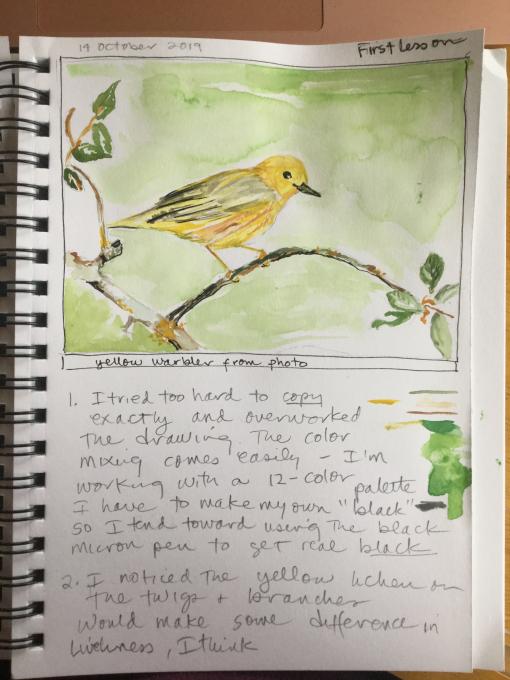

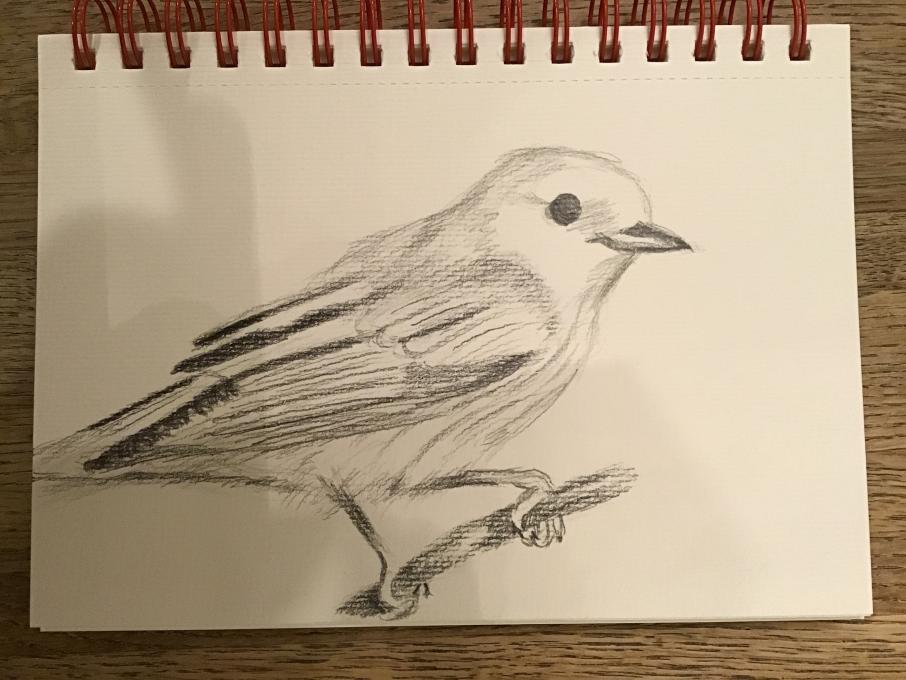 1. From my previous drawing experience, I was aware of and looking for the dark and light areas of the bird. What was more difficult was trying to get the proportions correct — the head is too big, the legs too short, and I did not leave enough room for the tail. I tend to draw large.
2. Drawing from the picture helped me see the different kinds of feathers on the warbler, e.g, long, distinct feathers on the wings and tail and shorter fluffier, feathers on the bird’s neck and belly, though I didn’t draw them as well as I wanted. If nature journaling, it would probably be harder to see th see details on a moving bird at a distance.
1. From my previous drawing experience, I was aware of and looking for the dark and light areas of the bird. What was more difficult was trying to get the proportions correct — the head is too big, the legs too short, and I did not leave enough room for the tail. I tend to draw large.
2. Drawing from the picture helped me see the different kinds of feathers on the warbler, e.g, long, distinct feathers on the wings and tail and shorter fluffier, feathers on the bird’s neck and belly, though I didn’t draw them as well as I wanted. If nature journaling, it would probably be harder to see th see details on a moving bird at a distance.  TT
TT 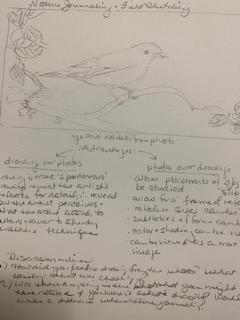 1. From Betsy: While drawing from the photo, I liked first setting the boundary/border for the drawing & then studying the relationships between the bird, the twigs, leaves, etc. I loved how the bird's legs formed an unexpected angle & how the eye looked so bright, with that one little sparkle. It felt really great again to put a plain #2 Ticonderoga in my hand & sketch away. Just getting started came really easily, as did the desire to sketch quickly. What was difficult was realizing that I'm a lot like this bird, always on the move, always looking for the next thing...not for survival's sake, like the warbler, but as my pattern of thinking & responding, my impatience. It was good to focus on the graceful bird, somewhat at rest, but...always on the move, always looking out, and always beautiful. Thank you! Because I can feel my brain operating differently when I draw, and that is so nice to notice, I was able to figure out how to "insert the image" into this e-mail & then to respond in this way. This is no small feat for me, so thank you for your deference, as I am sure this technology is easy stuff for many of you. It's not for me! I would imagine for many of us, though of course I don't really know, maybe especially for the artist who enrolled in this course as a birthday present, we have a chance to think about how we "see;" we have a chance to focus on ourselves as we focus on what we have always loved to do -- to draw. Ah, self-knowledge. Thank you!
2. I really noticed the shading & "implied" feathering & how the beak "sat." The veining on the leaves & the twists & textures in the twigs added to the action. The warbler's perch, his strong sure grip, though it lasts mere split seconds, ensures the bird's survival, as does, conversely, the letting go of the grip. This bird has a rounder head than I would have imagined. And what a sunny color. Look at how streamlined & aerodynamic he is. Like a sunbolt. Amazing!
1. From Betsy: While drawing from the photo, I liked first setting the boundary/border for the drawing & then studying the relationships between the bird, the twigs, leaves, etc. I loved how the bird's legs formed an unexpected angle & how the eye looked so bright, with that one little sparkle. It felt really great again to put a plain #2 Ticonderoga in my hand & sketch away. Just getting started came really easily, as did the desire to sketch quickly. What was difficult was realizing that I'm a lot like this bird, always on the move, always looking for the next thing...not for survival's sake, like the warbler, but as my pattern of thinking & responding, my impatience. It was good to focus on the graceful bird, somewhat at rest, but...always on the move, always looking out, and always beautiful. Thank you! Because I can feel my brain operating differently when I draw, and that is so nice to notice, I was able to figure out how to "insert the image" into this e-mail & then to respond in this way. This is no small feat for me, so thank you for your deference, as I am sure this technology is easy stuff for many of you. It's not for me! I would imagine for many of us, though of course I don't really know, maybe especially for the artist who enrolled in this course as a birthday present, we have a chance to think about how we "see;" we have a chance to focus on ourselves as we focus on what we have always loved to do -- to draw. Ah, self-knowledge. Thank you!
2. I really noticed the shading & "implied" feathering & how the beak "sat." The veining on the leaves & the twists & textures in the twigs added to the action. The warbler's perch, his strong sure grip, though it lasts mere split seconds, ensures the bird's survival, as does, conversely, the letting go of the grip. This bird has a rounder head than I would have imagined. And what a sunny color. Look at how streamlined & aerodynamic he is. Like a sunbolt. Amazing! 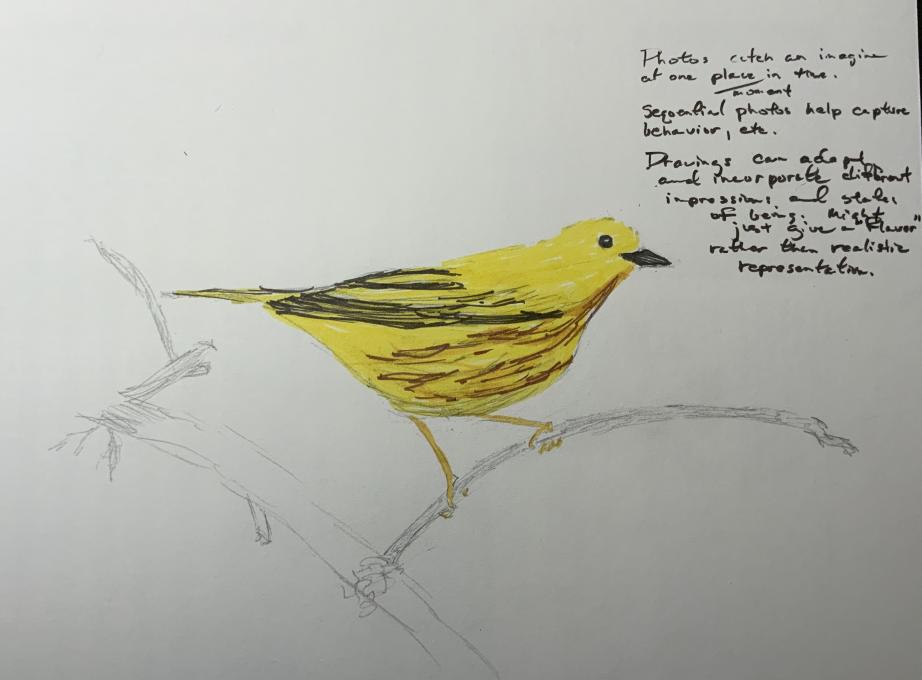 1. I felt that it was tricky getting the birds slight twist of the head okay. I am not a watercolorist, so I used marker to give an impression of the feathers and markings. It is a start.
2. I think you definitely notice more of the subtleties in the birds positioning and markings when you are trying to draw it. When I am out in the field photographing I try to get a clear, interesting shot within the birds environment at the moment. It might take a few photos to get enough data to make a good ID. I guess in nature journaling you have to decide if you want to make an impression and collect some data of your time in nature or if you are interesting in being more realistic.
1. I felt that it was tricky getting the birds slight twist of the head okay. I am not a watercolorist, so I used marker to give an impression of the feathers and markings. It is a start.
2. I think you definitely notice more of the subtleties in the birds positioning and markings when you are trying to draw it. When I am out in the field photographing I try to get a clear, interesting shot within the birds environment at the moment. It might take a few photos to get enough data to make a good ID. I guess in nature journaling you have to decide if you want to make an impression and collect some data of your time in nature or if you are interesting in being more realistic. 
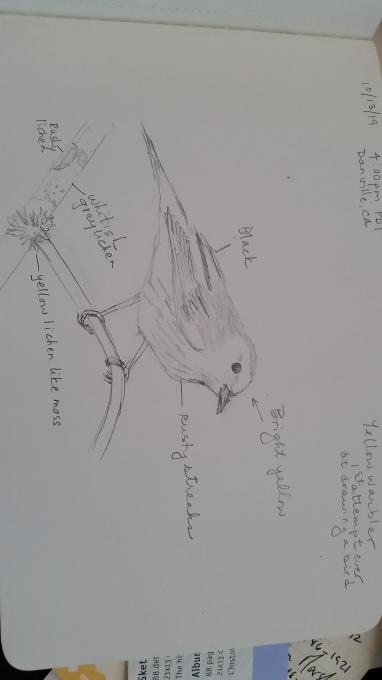 I agree with Barbara, it took me a while to take pencil in hand but I found the entire exercise rewarding. The more I looked and drew, the more I saw. Interesting!
I agree with Barbara, it took me a while to take pencil in hand but I found the entire exercise rewarding. The more I looked and drew, the more I saw. Interesting! 
